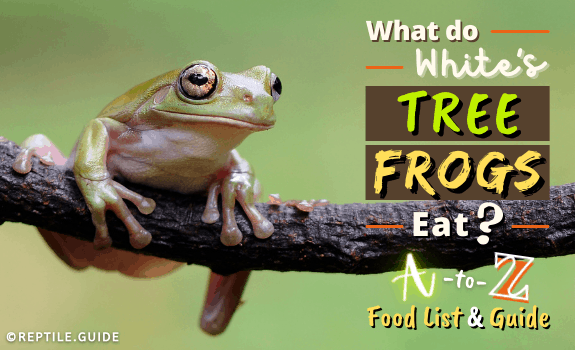White’s tree frogs (Ranoidea caerulea) are among the best species for novice amphibian keepers.
They are relatively easy to house, require lower humidity than other species, and have pretty simple dietary requirements.
These frogs are known to eat a diverse range of foods in the wild but are prone to obesity in captivity. As a frog keeper, it’s your job to provide your pet with all of the nutrients it needs.
In This Article
What You’ll Learn:
- What White’s tree frogs eat
- Essential nutrients for White’s tree frogs
- Ideal feeding schedule for frogs of any age
- How to provide a balanced diet for White’s tree frogs
- Feeder insect choices (staples, treats, and foods to avoid)
- Health disorders related to diet (and how to prevent them)
- Essential vitamins and minerals (and how to provide them)
- …and much more!
What Do White’s Tree Frog Eat in the Wild?
In their native range of Australia and New Guinea, these frogs survive on a diverse and plentiful diet of tropical insects. Their prey includes grasshoppers, roaches, and moths.
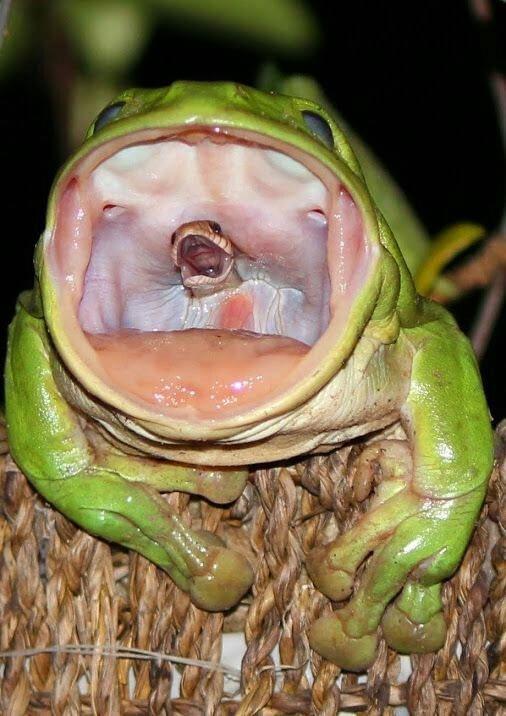
White’s tree frogs are primarily insectivorous. Like other species – such as the Pacman frog – White’s tree frogs will eat pretty much anything they can swallow. Large individuals even prey on rodents and reptiles (including small snakes).
Fun Fact: In one case, an Australian photographer even witnessed a White’s tree frog consuming a live taipan. These are among the most deadly venomous snakes on the planet.
White’s tree frogs use two distinct feeding modes when tackling different prey. Their sticky tongue can snare smaller insects, or they can scoop prey into their mouths using their front feet.
Creating a Healthy Frog Diet
Like humans, frogs require a balanced diet to stay healthy. There are several critical components to a healthy frog diet.
First, there are the macronutrients. These are the primary nutrients that should make up most of your frog’s diet. Frogs require them in greater quantities than any other nutrients.
The essential amphibian macronutrients – and their main functions – are:
- Protein – Used to maintain organs and muscles, facilitate growth, and provide energy.
- Lipids (fats and fatty acids) – Provide lots of energy, regulate cholesterol, and serve as building blocks for important chemicals in the body.
- Carbohydrates (fiber) – Aid in moving material through the gut – preventing impaction. May also provide some energy.
Expert tip: too much fiber can lead to liver problems or impaction of the gut.
Hard-bodied, adult insects should make up most of a White’s tree frogs’ diet. These are typically 30-60% protein and 10-30% fat. The rest consists of fiber and ash.
“Ash” is essentially the insect components that don’t consist of protein, lipids, or carbohydrates. Ash contains many additional vitamins and minerals, but not enough to sustain your frog entirely.
Vitamins and minerals are nutrients that frogs require in smaller quantities. Frogs may not need much of these to survive, but they’re still essential.
Essential vitamins and minerals for White’s tree frogs include vitamin A, calcium, and phosphorus.
Learn more about what do other frogs eat in this dedicated article.
Crickets
Crickets are the most highly recommended staple foods for White’s tree frogs. They’re widely available to purchase both in stores and online and come in a range of sizes. They’re also easy to breed.
Always feed appropriately sized crickets (small enough to fit in your frog’s mouth comfortably). A good rule of thumb is to avoid foods larger than the width between a frog’s eyes. Also, avoid placing too many crickets in a terrarium at once. Remove crickets if they start to attack your frogs.
The most common pet store varieties are pinhead, brown, black, and banded crickets.
Pinhead (or micro) crickets are newborn crickets used to feed smaller animals. These are an excellent choice for White’s tree frogs under 1.5 inches. Pinheads are too small to offer to adult White’s tree frogs.
Both species of brown crickets (Acheta domestica and Gryllus asimilis) are good choices for adult White’s tree frogs. They’re both silent throughout most of their lifespan. You may find that only one species is available in your region.
Black crickets (Acheta assimilis) may be slightly more aggressive than brown crickets. They’re also prone to chirping incessantly! One advantage of black crickets is that they can be larger and meatier than other species.
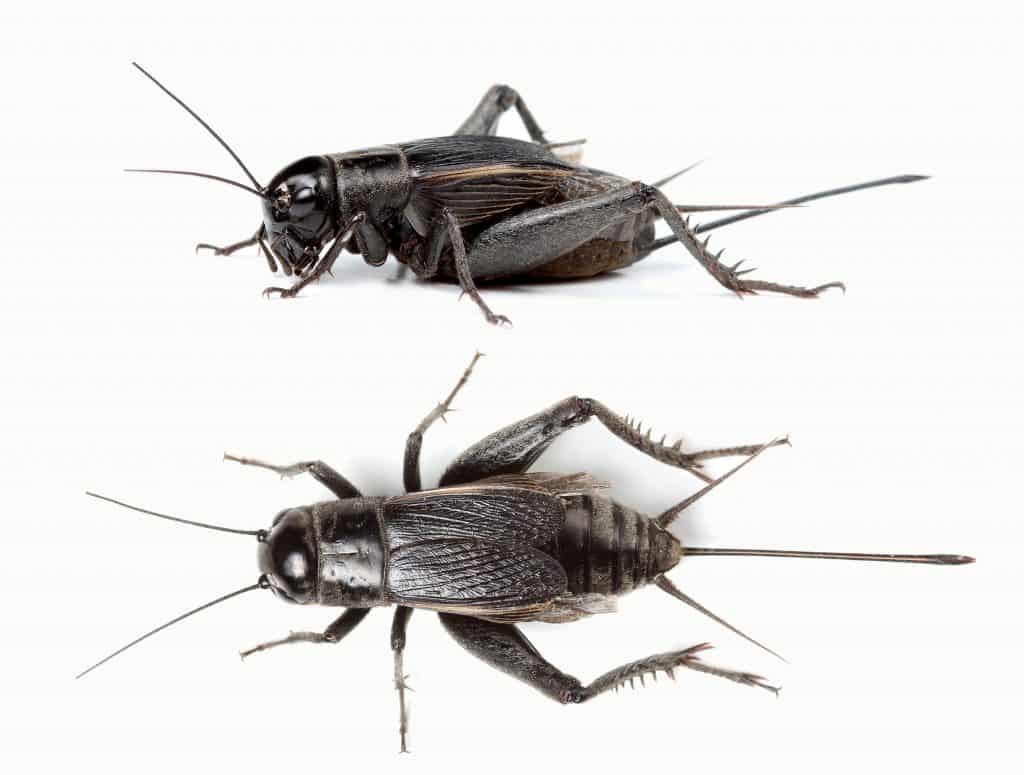
Banded crickets are the least aggressive variety. They also have a longer lifespan than other crickets. One downside is that banded crickets can jump pretty high. This ability makes them more likely to escape than other species.
Expert Tip: Find out when your local pet store restocks crickets and aim to purchase shortly after. Doing this will maximize the number of live crickets in each tub.
Foods to Offer Regularly
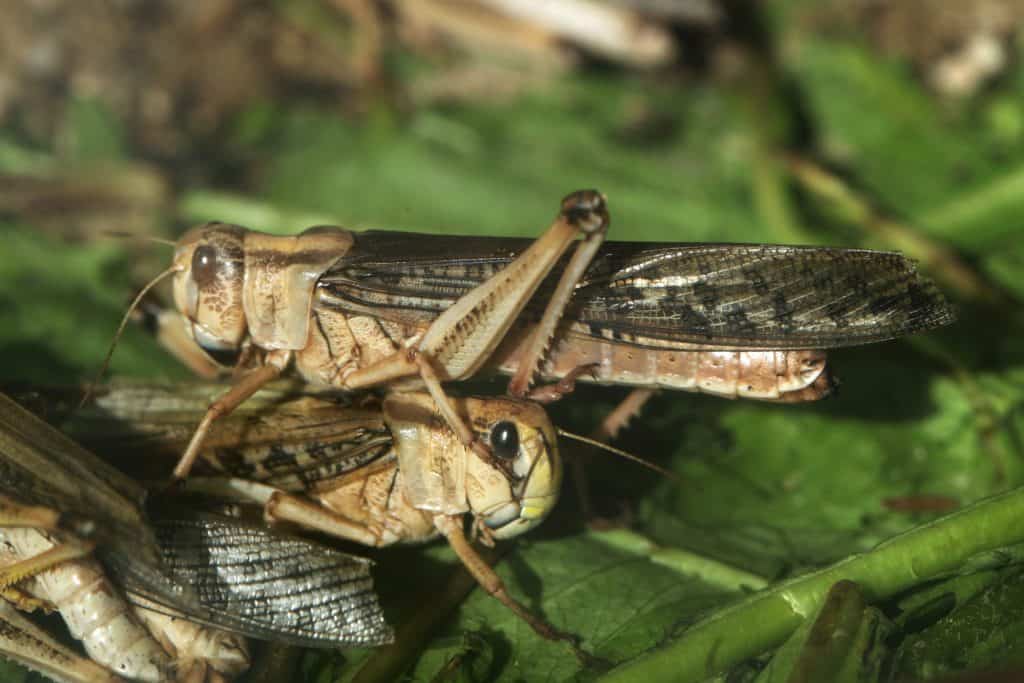
Most keepers feed their White’s tree frogs a diet predominantly based on gut-loaded crickets.
You may also offer other insects regularly to spice up your frog’s diet. Offer these in place of crickets, once every two or three feeds.
Below are some of the other popular feeder insects suited for White’s tree frogs.
Cockroaches
There are many varieties of cockroaches available as feeder insects.
Medium-sized dubia roaches (Blaptica dubia) are an excellent choice for White’s tree frogs. They’re high in protein and low in fat relative to crickets. They also contain around twice as much calcium.
Dubia roaches can be purchased as nymphs or as adults. Unfortunately, dubia roaches are banned in certain countries and regions.
Discoid roaches (Blaberus discoidalis) are another great choice, with similar nutritional contents. In some regions (such as Florida), these are a legal alternative to Dubia roaches.
Expert tip: Cockroaches lack linoleic acid, an essential nutrient. This is one reason why they should not make up the majority of your frog’s diet.
Grasshoppers
Grasshoppers, also known as locusts or simply “hoppers,” are another excellent food source for added variety. They can be purchased from pet stores and are easy to breed.
In many areas, it is best to avoid wild-caught grasshoppers. They feed on plant material and can sequester toxins in their bodies. The toxins can make them poisonous to predators like frogs.
Silkworms
Silkworms are larvae of the silk moth (Bombyx mori). Unlike most other larvae, silkworms can be offered to frogs regularly. They are low in fat, easily digestible, and high in protein. They also contain plenty of vitamins and minerals, such as calcium.
All in all, silkworms are among the most nutritious feeder insects. They are also a good choice for frogs that aren’t eating. We’ll discuss this in more detail later on.
Occasional Treats
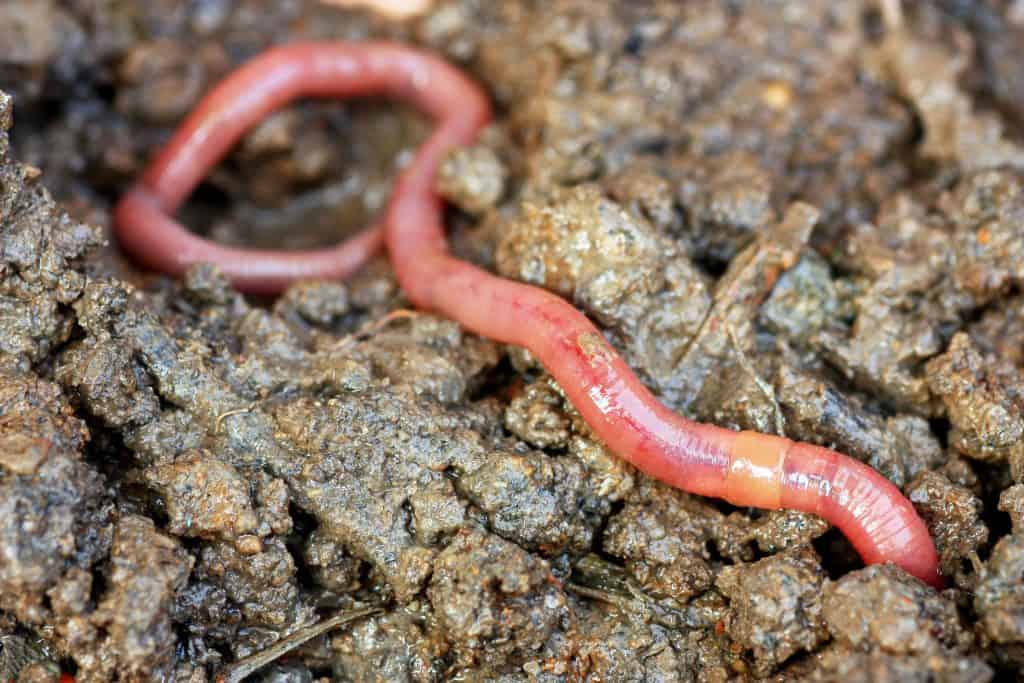
Your frog should consume some foods only once per month due to their high fat content.
Remember that obesity is a common problem among White’s tree frogs, so it’s important to avoid feeding high-fat foods regularly.
Earthworms
Earthworms are among the best treat choices for White’s tree frogs. They are high in protein and calcium while also low in fat. Worms can be purchased or collected from the wild.
Waxworms
Waxworms (Galleria mellonella) are high in lipids, so they must only be offered as treats once in a while. Their high energy content makes them useful for helping underweight frogs regain weight.
Waxworms can also be used to provide a boost to mothers who recently laid eggs.
Mealworms
Mealworms (Tenebrio molitor) are a form of beetle larva. They are easy to find in pet stores and can be a good source of lipids for White’s tree frogs. They also contain lots of fiber, unlike waxworms, due to their harder exterior.
Avoid feeding adult mealworm beetles to frogs. Their tough exterior is indigestible and can cause impaction.
Pinky & Fuzzy Mice
Many White’s tree frog keepers offer thawed mice as an occasional treat (once per month or less). Note that pinkies or fuzzies are very fattening for frogs. Avoid these foods if your frog is already overweight.
Before feeding pinkies or fuzzies to a frog, you must allow them to thaw thoroughly.
Frogs will also only recognize these items as food if they are moving. Most keepers solve this by using tongs to wiggle prey, simulating movement.
Expert Tip: Rodents are not a vital part of the White’s tree frog diet. Other treat species (particularly earthworms) can be offered instead.
Slugs and snails
Slugs and snails make great treats for amphibians. Snail shells are also high in calcium. Ensure that snails are small enough to be safely swallowed by your frog.
Foods to Avoid
Your frog will eat anything that moves. Unfortunately, some foods are toxic to frogs or provide a poor balance of nutrients.
It is your job to avoid feeding White’s tree frogs anything that could be harmful to their health. This list includes many common foods that are NOT suitable for White’s tree frogs.
Table Scraps
Human foods are not suitable for insectivorous animals such as the White’s tree frog. They’re typically high in fat, salt, and preservatives.
Commercial Pet Foods
Mammals have different nutritional requirements to White’s tree frogs. Never feed cat and dog foods to frogs.
Butterworms
Butterworms (Chilecomadia moorei) are known to cause chemical burns in gecko species. It’s not clear whether these effects occur in frogs.
Due to the sensitivity of amphibian skin, we advise keepers of White’s tree frogs to avoid using butterworms as feeder insects.
Superworms (Morio Worms)
Superworms (Zophobas morio) are similar to mealworms but larger. Feeding superworms to frogs is not recommended due to their large size and poor digestibility.
Plant Material
Never attempt to feed fruit or other plant materials to frogs. Adult frogs are strict carnivores and are unable to derive nutrients from plant matter.
Contaminated Foods
Insects collected from the wild can contain toxic chemicals from nearby pesticide applications or a diet of poisonous plant species.
If you’re unsure whether an area or an insect is safe, avoid feeding it to your pet.
Live Mice
Even if your frog will eat fuzzy or pinky mice, NEVER attempt to feed live mice to a White’s tree frog.
Live feeding not only causes unnecessary suffering but could also harm your frog. Mice possess incredibly sharp teeth and can seriously injure or kill amphibians.
Potentially Toxic Insects
Some insects are toxic to frogs. The most common examples are:
- Ladybugs
- Millipedes
- Stink bugs
- Wild hornworms
- Wild grasshoppers
Expert tip: Other insects can be toxic if they feed on poisonous plants. If you are unsure, it is best to play it safe and avoid feeding wild-caught insects altogether.
Vitamin and Mineral Supplements
Supplements are an essential part of captive amphibian diets.
It’s important to supply calcium, vitamin A, and vitamin D3 in sufficient quantities to maintain your frog’s health.
There are many multivitamin supplement mixes available from specialist stores or online. Be sure to look for supplements that are specifically tailored to amphibian needs.
It can be helpful to cycle through a few different supplement brands each month. This variety helps to ensure that your frog receives a broad spectrum of nutrients.
Expert Tip: Amphibians are unable to obtain vitamin A from beta carotene. Provide vitamin A or retinol as part of your supplementation regime.
Apply specially formulated amphibian supplements to food every other feed.
Most keepers do this by shaking prey items in a container with a small amount of supplement powder. This process is known as “dusting.”
Water
Frogs absorb water through their skin rather than through their mouths.
Mist your terrarium daily with distilled or spring water to provide hydration for your frogs.
You should still provide a water bowl, as well. It should be shallow enough for frogs to sit in comfortably. It should also be wide enough to accommodate multiple frogs.
Ensure that water is always clean and free of dead insects.
Ideal Feeding Schedule
Appetites vary with age, as young frogs require additional energy to grow. Younger frogs need food more often than adults.
You can determine how often to feed a frog based on its approximate SVL (snout-to-vent length). You can measure from the tip of a frog’s snout to the end of its body (where the vent is located) to determine its SVL.
Adults (>3 Inches)
Offer crickets (and other staples) to adult frogs around two or three times per week.
Adult frogs will typically eat around three large crickets (up to one inch) per feed.
Treats should be offered around once per month.
Subadults (1.5-3 Inches)
Offer subadult frogs staple foods every other day.
Treats should be offered around once per month, as with adults.
Froglets (<1.5 Inches)
Froglets are frogs that have recently completed their metamorphosis.
They require lots of energy for growth but are only able to take small food items. Feed daily at this stage.
How to Feed Your White’s Tree Frog
Simply place food in the terrarium and observe. Despite their “dumpy” reputation, White’s tree frogs are natural-born predators!
Some foods, such as worms and grubs, can be placed in a bowl. Feeding in a bowl prevents your frog from ingesting the substrate during feeding.
Feed your frog as much as they will eat in a 15-20 minute period. This timeline allows you to ensure that they receive enough food while avoiding overfeeding.
Many keepers opt to tailor insect quantities based on appetite to prevent obesity.
What to Do if Your White’s Tree Frog Isn’t Eating
If your frog stops eating crickets, try offering a different food instead. Silkworms and waxworms are great for triggering a feeding response in picky animals. Sometimes, this will be all that’s needed to get your frog eating again.
Check the humidity level and temperature of your terrarium to ensure that both are within a suitable range. For details about the ideal environmental conditions for White’s tree frogs, check out our comprehensive care guide for this species.
Seek help from a specialist veterinarian if your frog still refuses to eat.
White’s tree frogs can survive for up to a month without food, but this is usually a sign that something is wrong.
